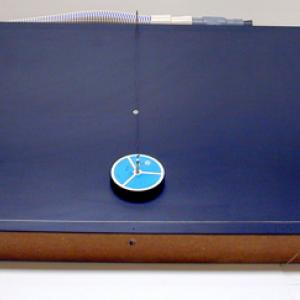College of Liberal Arts & Sciences
3A10.40 - Variaible "g" Pendulum
Tilt the air table to the desired angle. Attach the air puck on a string to the upper side of the air table. Set the pendulum in motion and time the oscillations either with a stop watch or photo gate. Reset the angle and retime.
- Hubert Biezeveld, "The Period of a Swinging Rod in an Oscillating Frame of Reference", TPT, Vol. 50, # 9, Dec. 2012, p. 550.
- David Schultz, "An Inexpensive, Multi-Purpose Physical Pendulum", TPT, Vol. 50, # 7, Oct. 2012, p. 436.
- Jose Feliciano, "The Variable Gravity Pendulum", TPT, Vol. 36, # 1, p. 51 - 52, Jan. 1998.
- Robert Ehrlich, "Air Table Experiments Without an Air Table", TPT, Vol. 23, # 2, Feb. 1985, p. 113 - 116.
- John B. Kwasnoski and Richard S. Murphy, "The Classic Pendulum Experiment - On Jupiter or Saturn", AJP, Vol. 52, #1, Jan. 1984, p. 85.
- David Kutliroff, "40, Pendulums - Dependency on 'g'", 101 Classroom Demonstrations and Experiments For Physics Teachers, p. 91.
- David Kutliroff, "51, A Determination of 'g'", 101 Classroom Demonstrations and Experiments For Physics Teachers, p. 114.
- David Kutliroff, "52, Using a Magnet to Simulate a Changing Gravitational Field and Illustrate its Effect on a Pendulum", 101 Classroom Demonstrations and Experiments For Physics Teachers, p. 116.
- Roman Ya. Kerzerashvili, Alexander Sapozhnikov, "Abstract: Pendulum With Variable Acceleration", 2005 Apparatus Competition, Salt Lake City, UT.
Disclaimer: These demonstrations are provided only for illustrative use by persons affiliated with The University of Iowa and only under the direction of a trained instructor or physicist. The University of Iowa is not responsible for demonstrations performed by those using their own equipment or who choose to use this reference material for their own purpose. The demonstrations included here are within the public domain and can be found in materials contained in libraries, bookstores, and through electronic sources. Performing all or any portion of any of these demonstrations, with or without revisions not depicted here entails inherent risks. These risks include, without limitation, bodily injury (and possibly death), including risks to health that may be temporary or permanent and that may exacerbate a pre-existing medical condition; and property loss or damage. Anyone performing any part of these demonstrations, even with revisions, knowingly and voluntarily assumes all risks associated with them.
